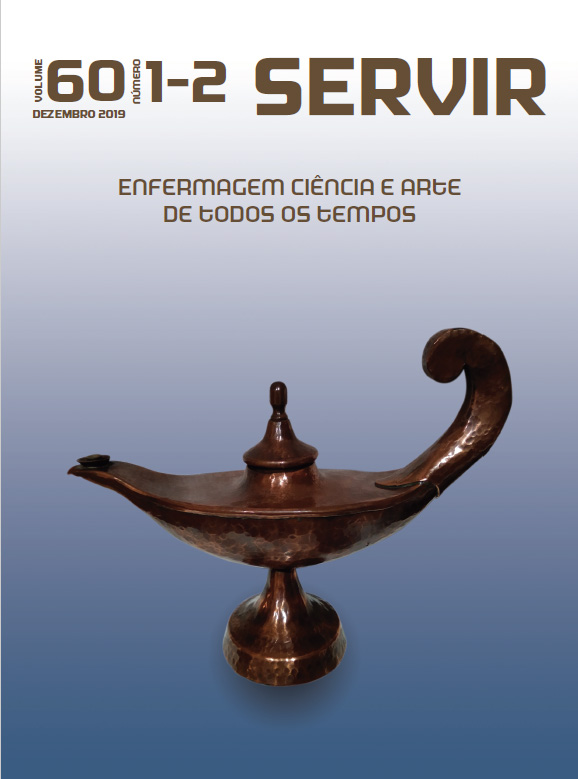The simulation in nursing and the development of non-technical skills in pre-hospital emergency context
Survey
DOI:
https://doi.org/10.48492/servir021-2.24489Keywords:
Nursing, simulation, non-technical SkillsAbstract
Goal: To analyze the simulation contribution to the development of non-technical skills in pre-hospital emergency nurses.
Method: Descriptive, analytic study using a Web questionnaire. A convenience sample was used in the central south region of Portugal made up by 52% of nurses (N = 65) working in prehospital emergency teams from three regions. The data were analyzed using the SPSS22, proceeding to a descriptive analysis of the same and subsequent analysis, using the measures of central tendency and dispersion. The study was approved by a competent Ethics Committee.
Results: The simulation emerges as a strategy used in the training of these professionals both in the school and work context, being valued for the acquisition and development of non-technical skills. Nurses value the use of non-technical skills at the event and context for study, identifying them clearly and assigning them different levels of relevance. Knowledge is regarded as important resources in the process of care in complex situations for which the Debriefing, as time of simulation, is considered by nurses relevant and important for learning.
Downloads
References
Amendoeira, José; Barroso, Isabel; Figueiredo, Maria do Carmo; Fonseca, Olímpia; Godinho, Celeste; Reis, Alcinda; Saragoila, Fátima & Silva, Mário (2014) Enfermagem Avançada. Contributo para o processo de teorização em Enfermagem. Revista UIIPS Vol2 (5): 232-249 https://www.ipsantarem.pt/wp-content/uploads/2014/03/Revista-da-UIIPS_N5_Vol2_ESSS_2014.pdf
José Amendoeira; Celeste Godinho; Alcinda Reis; Rosário Pinto; Mário Silva & Júlia Santos (2013) Simulação na educação em enfermagem. Conceitos em transição. REVISTA da UIIPS Dezembro Vol. 1 (4) 212-228 https://www.ipsantarem.pt/wp-content/uploads/2013/07/Revista-da-UIIPS_N4_Vol1_2013_ISSN-2182-9608.pdf
Amendoeira, José (2006). Enfermagem: Disciplina do conhecimento. Sinais Vitais (67): 19-27
Hunziker, Sabmina et al (2013). Importance of leadership in cardiac arrest situations: from simulation to real life and back. Swiss Med Wkly. 143:w13774 doi:10.4414/smw.2013.13774
American Heart Association (2010) Destaques das Diretrizes da American Heart Association 2010 para RCP e ACE. Guidelines CPR ECC: 28
Decker, Sharon; Sportsman, Susan; Puetz, Linda; Billings, Lynda. The evolution of simulation and its contribution to competency. J Contin Educ Nurs 2008;39(2):74-80
Galloway, S (2009). Simulation techniques to bridge the gap between novice and competent healthcare professionals. OJIN: The Online Journal of Issues in Nursing, vol.14, nº 2, Manuscript. DOI: 10.3912/OJIN.Vol14No02Man03
Blevins, S (2014). The impact of simulation on patient care. Nurses as Educators, March-April, vol 23, nº2, Medsurg Nursing
Parker, B & Myrick, F (2010) Transformative Learning as a context for Human Patient Simulation. Journal of Nursing Education 49 (6), 326-332
Locsin, RC, Slemp, LO, Lynn, Christine E (2008) Caring scholar response to: Grounding nursing simulations in caring: an innovative approach. International Journal for human Caring 12(2), 47-49
Hoadley, TA (2009) Learning advanced cardiac life support: a comparison study to the effects of low and high-fidelity simulation. Nursing Education Research 30 (2) 91-95
Gordon, CJ & Buckley, T (2009) The effect of high-fidelity simulation training on medical-surgical graduate nurses? Perceived ability to respond to patient clinical emergencies. Journal of Continuing Education in Nursing 40 (11), 491-498
Shinnick, M. A., Woo, M., Horwich, T. B., & Steadman, R. (2011, May). Debriefing: The most important component in simulation? Clinical Simulation in Nursing, 7(3), e105-e111. doi:l0.1016/j.ecns.2010. 11.005.
Creswell, John W. (2003). Research design Qualitative, Quantitative, and Mixed Methods Approaches, 2nd ed. London, Sage Publications, ISBN 0-7619- 2442-6
Bryman, Alan (2012). Social Research Methods, 4th Edition, Oxford University Press. ISBN-13: 978-0199588053
Sheehan, K. B. (2001), E-mail Survey Response Rates: A Review. Journal of Computer-Mediated Communication, 6: 0. doi: 10.1111/j.1083-6101.2001.tb00117.x
Hill, M.M. & Hill, A. (2002). Investigação por Questionário. Lisboa : Edições Sílabo, Lda.
Riem, N. Boat, S., Bould, MD, Tavares, W. Do technical skills correlate with non-technical skills in crisis resource management: a simulation study. Br J. Anaesth. 2012 Nov, 109 (5): 723-8 DOI: 10.109r/bje/aes256
Ordem dos Enfermeiros (2013). Modelo Integrado de Emergência Pré-Hospitalar. Acesso em 25-01-2014, acesso em 17 de setembro de 2015 https://www.ordemenfermeiros.pt/arquivo/comunicacao/Documents/2013/MIEPH_proteg.pdf
Sportsman, Susan Competency Education and Validation in the United States: What Should Nurses Know? Nursing Forum Volume 45, No. 3, July-September 2010. Pp.148-149
Nagle, BM, McHale, JM, Alexander, GA & French, BM (2009) Incorporating Scenario-Based Simulation into an Hospital Nursing Education Program. The Journal of Continuing Education in Nursing 40 (1), 18-25
Jeffries, PR (2005). A framework for designing, implementing, and evaluating simulations used as teaching strategies in nursing. Nursing Education Perspectives [Nurs Educ Perspect] Mar-Apr; Vol. 26 (2) 96-103.
Parker, B & Myrick, F (2010) Transformative Learning as a context for Human Patient Simulation. Journal of Nursing Education 49 (6), 326-332
Mezirow, J (1995) Transformative Learning: Theory to Practice. New Directions for Adult and Continuing Education 74, 5-12
Benner, P. (1984). From novice to expert: Excellence and power in clinical nursing practice. Menlo Park: Addison-Wesley, pp. 13-34
Lapkin, S & Levett-Jones, T (2011) A cost-utility analysis of medium vs. high-fidelity human patient simulation manikins in nursing education. Journal of Clinical Nursing 20, 3543-3552
Dreifuerst, KT (2009) The essentials of debriefing: A concept analysis. Nursing Education Perspectives 30 (2), 109-114
Downloads
Published
How to Cite
Issue
Section
License
In order to promote the free circulation of knowledge, Servir is open access journal. All its content is available and protected under the Creative Commons license (CC BY 4.0).
The journal allows self-archiving in institutional repositories of all versions, which may become immediately available






